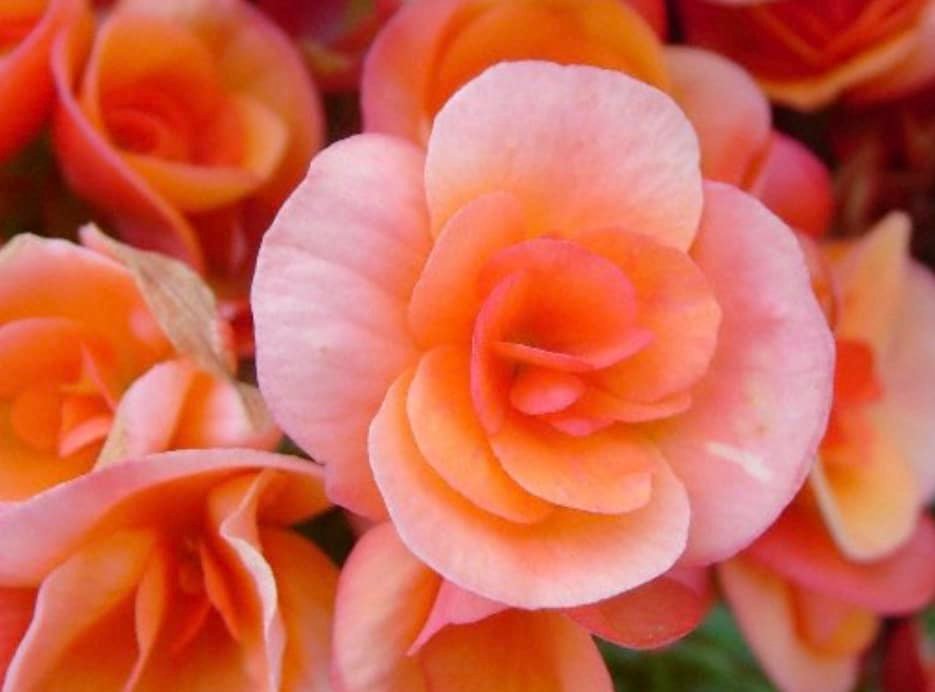Begonia
A balcony flower!
Flower Meditation
Pictures mlaure
Video made with Canva
Music depositphotos
The Begoniaceae family includes over 1,800 species of begonias, which are native to tropical and subtropical regions around the world. Begonias are a diverse group of plants, with numerous hybrids and cultivars that have been selectively bred to produce a wide range of flower colors, shapes, and sizes. Begonias are primarily grown for their ornamental value and are commonly used in garden beds, containers, and hanging baskets.
Classification of begonias
Kingdom: Plantae (plants)
Subkingdom: Tracheobionta (vascular plants)
Superdivision: Spermatophyta (seed plants)
Division: Magnoliophyta (flowering plants)
Class: Magnoliopsida (dicotyledons)
Subclass: Rosidae
Order: Cucurbitales
Family: Begoniaceae (begonia family)
Genus: Begonia

Botanicals of begonias
Begonia x semperflorens-cultorum: This is a popular cultivar of begonia, often grown as an annual. It has bright green foliage and produces clusters of small flowers in shades of white, pink, or red.
Begonia tuberhybrida: This is a group of tuberous begonia hybrids that are grown for their showy flowers. They come in a wide range of colors, including white, yellow, pink, red, and orange.
Begonia rex: This is a group of rhizomatous begonias that are grown for their striking foliage. The leaves are usually large and have intricate patterns and colors, such as silver, green, pink, and purple.
Begonia coccinea: This is a species of begonia that is native to Brazil. It has bright green foliage and produces clusters of red or pink flowers.
Begonia boliviensis: This is a species of begonia that is native to Bolivia. It has small, narrow leaves and produces clusters of tubular, orange or red flowers.
Begonia grandis: This is a species of begonia that is native to China and Japan. It has large, heart-shaped leaves and produces clusters of pink or white flowers.
Begonias are primarily grown for their ornamental value, as they produce beautiful flowers and foliage that can add color and texture to a garden or indoor space. Some species of begonia also have medicinal properties and have been used to treat a variety of ailments, including wounds, fever, and digestive issues. However, the plant can be toxic if ingested, so caution should be taken.
General characteristics of begonias
Size: Begonia plants range in size from small annuals that grow only a few inches tall, to larger species and cultivars that can reach up to 6 feet (1.8 meters) in height.
Flowers: Begonia flowers come in a wide variety of colors, shapes, and sizes, depending on the species and cultivar. They can be single or double, and may have frilly or ruffled edges.
Leaves: Begonia leaves also come in a variety of shapes and colors, and are often as prized for their foliage as they are for their flowers. Some species have large, showy leaves with intricate patterns and colors, while others have smaller, more simple leaves.
Habitat: Begonias are native to tropical and subtropical regions around the world, and they thrive in warm, humid environments.
Growing Conditions: Begonias prefer well-draining soil that is rich in organic matter. They require regular watering and should be kept in a warm, humid environment with filtered sunlight.
Reproduction: Begonias can be propagated from seed, cuttings, or by dividing the roots of mature plants.
Uses: Begonias are primarily grown for their ornamental value, and are commonly used in garden beds, containers, and hanging baskets. Some species of begonia also have medicinal properties and have been used in traditional medicine.
Begonias are relatively easy to care for, making them a popular choice for gardeners of all skill levels.
Planting and flowering season
Planting time and flowering season of begonias can vary depending on the species, climate, and location. Here are some general guidelines
Planting time: Begonias are usually planted in the spring after the last frost, or in the fall for overwintering in areas with mild winters. In tropical regions, begonias can be planted year-round.
Soil and location: Begonias prefer well-draining soil that is rich in organic matter. They also require filtered sunlight or partial shade and warm, humid conditions.
Planting depth: Begonias should be planted with the top of the bulb or rhizome just above the soil surface.
Flowering season: Begonias typically bloom in the summer and fall, depending on the species and location. Some species may also produce flowers in the winter or spring.
Maintenance: Begonias require regular watering and fertilization, especially during the growing season. Deadheading spent flowers can encourage the plant to produce more blooms.
Begonias are relatively easy to grow and care for, making them a popular choice for gardeners who want to add some color and texture to their gardens or indoor spaces.
OpenAI
Table with characteristics
| Characteristics | Description |
| Size | Range in size from small annuals to larger species and cultivars that can reach up to 6 feet (1.8 meters) in height |
| Flowers | Wide variety of colors, shapes, and sizes, depending on the species and cultivar |
| Leaves | Also come in a variety of shapes and colors, often as prized for their foliage as they are for their flowers |
| Habitat | Native to tropical and subtropical regions around the world |
| Growing Conditions | Well-draining soil rich in organic matter, warm and humid environment with filtered sunlight |
| Reproduction | Propagated from seed, cuttings, or by dividing the roots of mature plants |
| Uses | Primarily grown for their ornamental value, commonly used in garden beds, containers, and hanging baskets |
| Classification | Kingdom: Plantae, Division: Magnoliophyta, Class: Magnoliopsida, Order: Cucurbitales, Family: Begoniaceae, Genus: Begonia |
| Planting Time | Spring or fall, depending on the species and location |
| Planting Depth | Planted with the top of the bulb or rhizome just above the soil surface |
| Flowering Season | Summer and fall, depending on the species and location |
| Maintenance | Regular watering and fertilization, deadheading spent flowers |
Shop tip
Begonia on Amazon












